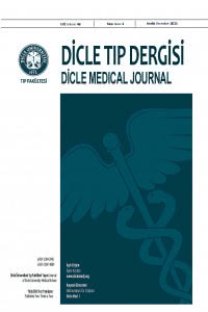Os trigonum sendromu: Geriye dönük karşılaştırmalı bir çalışma
Os trigonum syndrome: A retrospective and comparative study
___
- 1. David W. Stollerand R D. Ferkel. The Ankle and Foot. In: Magnetic Resonance Imaging in Orthopaedics and Sports Medicine, Vol. 1,3th edition. Lippincott Williams and Wilkins, 2007:940-7.
- 2. Tamer Kaya. Ayak Bileği: Kas İskelet-Yumuşak Doku Radyolojisi 2008;388-9
- 3. Karasick D, Schweitzer ME. The ostrigonum syndrome: imaging features. AJR Am J Roentgenol 1996 ;166(1):125-9.
- 4. Hedrick MR, McBryde AM.Posterior ankle impingement. Foot Ankle Int 1994;15(1):2-8.
- 5. Marotta JJ, Micheli LJ. Os trigonum impingement in dancers. Am J Sports Med 1992;20(5):533-6.
- 6. Akpınar F, Tosun N, İslam C, Aydınlıoğlu A .Os trigonum sendromu. AÜTD 1995;27(1):50-4.
- 7. Grogan DP, Walling AK, Ogden JA. Anatomy of the os trigonum. J Pediatr Orthop 1990;10(5):618-22.
- 8. Lawson JP. International Skeletal Society Lecture in honor of Howard D. Dorfman. Clinically significant radiologic anatomic variants of the skeleton. AJR Am J Roentgenol 1994;163(2):249-55.
- 9. Chiereghin A, Martins MR, Gomes CM, Rosa RF, Loduca SM, Chahade WH. Posterior ankle impingement syndrome: a diagnosis rheumatologists should not forget. Two case reports. Rev Bras Reumatol 2011;51(3):283-8.
- ISSN: 1300-2945
- Yayın Aralığı: 4
- Başlangıç: 1963
- Yayıncı: Cahfer GÜLOĞLU
Oculoglandular tularemia: A case report
Yasemin TORUN ALTUNER, Mustafa ÖZTÜRK, Dilek ULUBAŞ, Fatmagül BAŞARSLAN, Vefik ARICA
Approach to hypersplenism due to splenic metastasis of breast cancer: A case report
Mehmet KÜÇÜKÖNER, M.Ali KAPLAN, ALİ İNAL, Abdurrahman IŞIKDOĞAN, Uğur FIRAT, Akın ÖNDER, Feyzullah UÇMAK, Hakan ÖNDER, M. Recai AKDOĞAN
Türkan ÖZER TOKA, Erkan YULA, Alicem TEKİN, Özcan DEVECİ
Akut taşlı kolesistit olgularında endo-bag kullanımının yara yeri enfeksiyonu üzerine etkileri
Mustafa GİRGİN, BURHAN HAKAN KANAT, Refik AYTEN, Ziya ÇETİNKAYA
Oktay ERGENE, Cem NAZLI, Uğur KOCABAŞ, Hamza DUYGU, NİHAN KAHYA EREN, Zehra İlke AKYILDIZ, Ali Hikmet KIRDÖK, Rida BERİLGEN
Portal-systemic encephalopathy with hypermanganesemia: A case report and review of the literature
Gülay OKYAY ULUSAL, Ezgi YENİGÜN COŞKUN, Atakan PIRPIR, Osman ERSOY, İ. Safa YILDIRIM
Epidermoid cyst and lipoma with tethered spinal cord: A case report
İrfan KOCA, Ercan MADENCİ, Özlem ALTINDAĞ, Ekrem KARAKAŞ, Ali GÜR, Bahattin ÇELİK
Percutaneous closure of secundum atrial septal defects: Experience of a tertiary referral center
Oktay ERGENE, Cem NAZLI, Uğur KOCABAŞ, Hamza DUYGU, Nihan Kahya EREN, Zehra İlke AKYILDIZ, Ali Hikmet KIRDÖK, Rida BERİLGEN
Melek İNCİ, Mustafa Altay ATALAY, Ayşe Nedret KOÇ, Burçin ÖZER, Çetin KILINÇ
